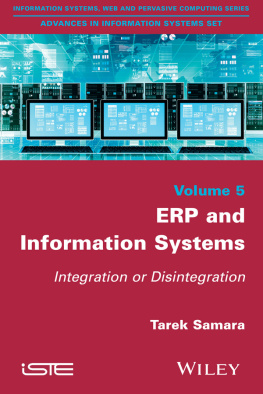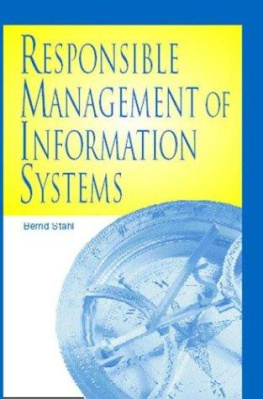Contents
Pagebreaks of the print version
ESSENTIAL TOPICS OF MANAGING
INFORMATION SYSTEMS
ESSENTIAL TOPICS OF MANAGING
INFORMATION SYSTEMS

Jun Xu
Southern Cross University, Australia

Published by
World Scientific Publishing Co. Pte. Ltd.
5 Toh Tuck Link, Singapore 596224
USA office: 27 Warren Street, Suite 401-402, Hackensack, NJ 07601
UK office: 57 Shelton Street, Covent Garden, London WC2H 9HE
British Library Cataloguing-in-Publication Data
A catalogue record for this book is available from the British Library.
ESSENTIAL TOPICS OF MANAGING INFORMATION SYSTEMS
Copyright 2020 by World Scientific Publishing Co. Pte. Ltd.
All rights reserved. This book, or parts thereof, may not be reproduced in any form or by any means, electronic or mechanical, including photocopying, recording or any information storage and retrieval system now known or to be invented, without written permission from the publisher.
For photocopying of material in this volume, please pay a copying fee through the Copyright Clearance Center, Inc., 222 Rosewood Drive, Danvers, MA 01923, USA. In this case permission to photocopy is not required from the publisher.
ISBN 978-981-121-355-7
For any available supplementary material, please visit
https://www.worldscientific.com/worldscibooks/10.1142/11647#t=suppl
Printed in Singapore
Preface
Information systems have become an essential part and a major resource of the organization; and they can radically affect the structure of an organisation, the way it serves customers, and the way it helps people in the organization to communicate both internally and externally, and the way an organisation runs its business. Managing information systems effectively and efficiently has become an important part of the life of 21st century managers. This book is about managing information systems and focuses on relationships between information, information systems, people and business. The impacts, roles, risks, challenges as well as emerging trends of information systems are an important element of the book. At the same time, many strategic and contemporary uses of information systems such as implementing enterprise planning systems for improving internal operation, adopting customer relationship management systems and supply chain management systems to enhance relations with customers and suppliers/partners respectively, and establishing knowledge management systems for better managing organizational knowledge resources as well as using different information systems for supporting managers decision making in all levels are an integral part of the book. In addition, essential and critical information systems management skills including using information systems for competitive advantages, planning and evaluating information systems, developing & implementing information systems, and managing information systems operation are a critical part of the book.
This book has ten chapters. strategic planning tools such as Porters five forces and value chain to analyse their competitive position, examine their competitive advantages, and identify relevant competitive strategies. Information systems can play a very important role in the success of an organisations identified competitive strategies.
also looks at another important aspect of information systems management: evaluation of initiatives/investments of information systems. There is an old saying: If you cannot measure it, you cannot manage it. Through systematic assessment of their information systems initiatives/investments, organizations can be effective in choosing right information systems projects and managing their chosen initiatives/investments. In order to measure the performance of information systems, organisations could use a set of metrics (such as net present value, return of investment, internal rate of return, payback period, and total cost of ownership). Meanwhile organisations should look beyond financial metrics, and take into consideration of financial and non-financial data, qualitative and quantitative information, tangible and intangible costs/benefits, and formal and informal processes.
looks at developing and implementing information systems. Correctly developed and deployed information systems can significantly contribute to the success of the business (e.g., enhancing competitive advantages, improving business performance). On the other hand, a poorly developed and implemented information system can have a damaging effect on business performance and can even cause a business to fail. To ensure successfully develop and implement information systems organizations need to adopt systems development life cycle (or its variations), which includes such activities as systems planning, analysis, design, development, testing, implementation, and maintenance. In addition, while organizations are developing and implementing information systems they have to pay close attention to such areas as project management, change management, and risk management, these areas are critically associated with the success of information systems development and implementation.
also discusses data resources management. As a result of global connectedness, the wide adoption of computing tools & mobile devices, the rapid advancement of Internet technologies, and more powerful computing capability, gathering and analysing large (or very large) volume of data is quickly becoming popular among organizations for reasons such as better understanding customers, better utilizing data resources & computing infrastructure, designing new business models, and creating new revenue streams.
touches on the information systems infrastructure management and discusses hardware, software, networks and telecommunications management. Hardware is a vital part of computer systems and provides the underlying physical foundation for firms information systems infrastructure. Other infrastructure components of software, networks and telecommunications require hardware for their storage and operation. To be useful, hardware needs software, which gives instructions that control the operation of a computer system. Networks and Telecommunications enable large and small businesses to communicate internally between staff and externally with customers, suppliers, business partners, strategic alliances and others. Making the right decision in relation to information systems infrastructure is vital to the success of the business.
deals with functional information systems and discusses cross-functional information systems. Traditionally businesses are operated by dividing the organisation into various functions (e.g., accounting, marketing, finance, productions/operations management, human resources management) in a silo structure with each having its own information systems and tending to work in isolation. In order to deal with these problems of silo approach (e.g., information recreation, information errors, communication gaps among departments, loss of information arising from inaccurate information and not-timely shared information, and lack of consistent services to customers), managers need to think beyond the walls of the organisation. Thus there is a need for a cross-functional approach, which focuses on business process and customer services.










